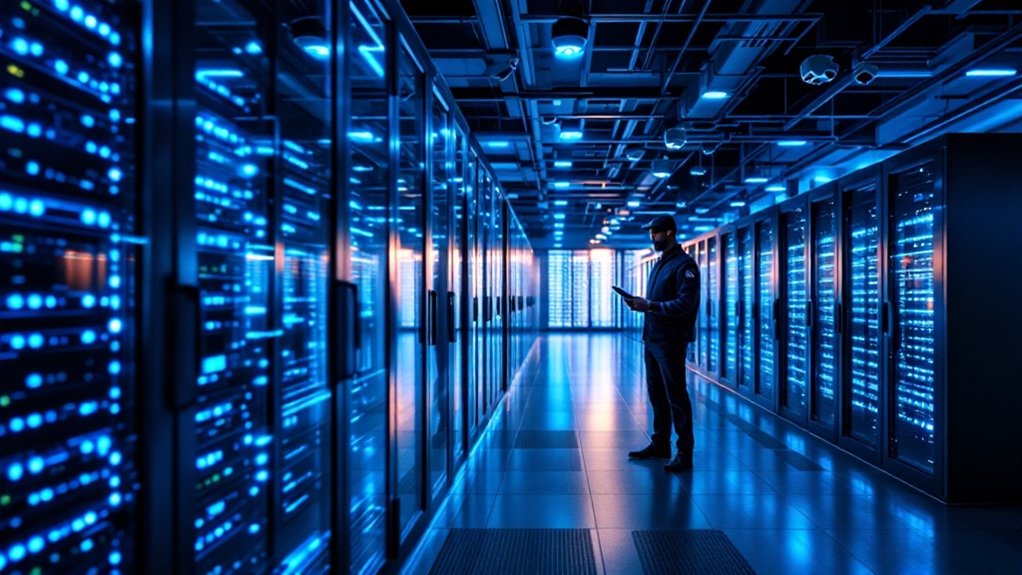Data centers are critical to modern digital infrastructure. However, they face numerous physical security risks that could compromise their operations. Understanding these vulnerabilities is essential for effective risk management. From natural disasters to insider threats, the spectrum of potential dangers is broad. Implementing robust security measures is not just a precaution but a necessity for safeguarding sensitive information. What specific strategies can fortify these crucial installations against evolving threats?
The Importance of Physical Security in Data Centers
Although technological safeguards are essential, the significance of physical security in data centers cannot be overstated. Physical security measures provide a fundamental layer of protection, ensuring that only authorized personnel can access sensitive areas. This is essential to safeguard critical infrastructure, prevent tampering, and maintain operational integrity. Security protocols, including surveillance systems, controlled access systems, and onsite security personnel, play essential roles in deterring unauthorized entry and enhancing overall safety. Additionally, physical barriers such as fences and secure doors contribute to preventing environmental hazards and ensuring equipment protection. By integrating robust physical security strategies, data centers can effectively protect their assets and uphold compliance with regulatory standards. Ultimately, strong physical security measures fortify the infrastructure against potential vulnerabilities. Furthermore, data centers are known for their meticulous selection process for partners, ensuring that only trustworthy individuals contribute to maintaining and enhancing security measures.
Common Threats to Data Center Security
Data centers face various security threats that can compromise their operations. Among the most prevalent risks are insider threats, where employees may intentionally or unintentionally cause harm, and physical intrusions, which involve unauthorized access to facilities. Understanding these common threats is vital for maintaining the integrity and security of data center environments. Furthermore, implementing modern data management systems can help mitigate risks by improving overall service and response to potential threats.
Insider Threats
While physical security measures are crucial for safeguarding data centers, insider threats pose significant challenges that can often be overlooked. These threats arise from employees, contractors, or other individuals with authorized access, who may intentionally or unintentionally compromise security. Insider threats can manifest as data theft, sabotage, or unintentional breaches due to negligence. The motivations behind such actions may include financial gain, personal grievances, or a lack of awareness about security protocols. Organizations must prioritize monitoring access controls and implementing robust training programs to mitigate these risks. Regular audits and fostering a culture of security awareness are essential in identifying potential insider threats before they escalate, thereby protecting sensitive data and ensuring the integrity of the data center environment.
Physical Intrusions
If a data center’s physical security is compromised, the consequences can be severe, leading to unauthorized access and potential data breaches. Physical intrusions encompass a variety of threats, including burglary, vandalism, and sabotage, which can all jeopardize sensitive information and infrastructure. Intruders may exploit inadequately secured perimeters, bypass surveillance systems, or manipulate access controls to gain entry. The presence of insiders, as previously discussed, can further complicate security, enabling collusion or acts of sabotage. Additionally, natural disasters can also cause physical intrusions, inadvertently allowing for security breaches. Organizations must adopt thorough measures—such as reinforced barriers, advanced monitoring technologies, and strict access protocols—to mitigate these risks and safeguard critical assets in a data center environment.
Natural Disasters and Their Impact
Natural disasters pose significant risks to data centers, with various types such as floods, earthquakes, and hurricanes threatening physical infrastructure. Evaluating vulnerability to these events is vital for identifying potential weaknesses in security measures. Effective mitigation and recovery strategies are essential to guarantee operational continuity in the face of such catastrophic occurrences. Additionally, data centers often discuss best network management practices during webinars to help clients plan for resilience against such threats.
Types of Natural Disasters
As climate change continues to reshape weather patterns and seismic activity, various types of natural disasters pose significant threats to data centers. Flooding, often caused by heavy rainfall or storm surges, can infiltrate facilities and damage equipment. Earthquakes present risks of structural failure and equipment displacement, compromising operations. Hurricanes and tornadoes can lead to high winds and flying debris, causing external and internal damage. Wildfires, increasingly prevalent in certain regions, can threaten data centers through heat exposure and smoke, potentially disrupting power supply. Additionally, extreme temperatures can strain cooling systems, threatening data integrity. Recognizing these natural disasters is vital for understanding their potential impact on data center security and operational continuity.
Assessing Disaster Vulnerability
Evaluating disaster vulnerability is crucial for safeguarding data centers against the unpredictable impacts of environmental hazards. This involves analyzing potential threats from natural disasters such as floods, earthquakes, hurricanes, and wildfires. Understanding local geography and climate patterns is essential, as vulnerabilities can vary substantially by location. For instance, coastal data centers may face flooding and storm surges, while those in seismic zones must prepare for earthquakes. Assessments should encompass both historical data on past events and projections for future climate scenarios. Additionally, identifying critical physical assets within the facility, such as power supplies and cooling systems, can clarify the potential impact of these disasters. Ultimately, a thorough evaluation helps prioritize resources and informs strategic planning to enhance resilience.
Mitigation and Recovery Strategies
To effectively mitigate the risks posed by natural disasters and guarantee swift recovery, data centers must implement thorough strategies tailored to their specific vulnerabilities. This includes conducting risk assessments to identify potential hazards such as floods, earthquakes, and storms. Resilient infrastructure, including reinforced structures and flood defenses, plays a vital role in protecting assets. Additionally, investing in advanced technology such as real-time monitoring systems can provide early warnings of impending threats. Developing an exhaustive disaster recovery plan is equally important, encompassing backup systems, data redundancy, and regular testing of recovery protocols. Training staff in emergency response can enhance preparedness, ensuring that personnel are equipped to act quickly in the event of a disaster, minimizing downtime and facilitating rapid recovery operations.
Unauthorized Access and Intrusion Risks
Unauthorized access and intrusion risks pose significant threats to the integrity and security of data centers, where sensitive information is stored and processed. These risks can manifest through physical breaches, such as unauthorized individuals gaining entry to restricted areas, which may result in theft of hardware or data manipulation. Camera blind spots, inadequate access controls, and lack of surveillance can exacerbate these vulnerabilities, making it easier for intruders to exploit weaknesses. Moreover, insufficient employee training regarding security protocols may unintentionally facilitate unauthorized access. Data centers need to implement robust physical security measures, including biometric access controls and continuous monitoring, to mitigate the likelihood of such incidents. Regular audits and updates to security protocols are essential to address evolving threats effectively. Additionally, fostering a culture of curiosity in inquiries about security practices among employees can greatly enhance awareness and prevention of unauthorized access risks.
Insider Threats and Employee Negligence
While physical breaches often capture attention, insider threats and employee negligence represent equally critical vulnerabilities within data centers. Employees, whether maliciously or inadvertently, can compromise sensitive systems and data. Insider threats may arise from disgruntled employees seeking revenge or unauthorized access to confidential information. Conversely, employee negligence, such as failing to safeguard passwords or neglecting to follow security protocols, can lead to unintentional breaches. These vulnerabilities can be exacerbated by a lack of ongoing training, which leaves staff ill-equipped to recognize potential security risks. Organizations must implement thorough training programs and enforce strict access controls to mitigate the risks posed by insiders. Addressing these vulnerabilities is essential for maintaining the integrity and security of data center operations. Additionally, ongoing training for employees in data security is vital to cultivate a secure operational environment.
Environmental Risks and Infrastructure Vulnerabilities
Environmental risks and infrastructure vulnerabilities pose significant threats to the security and operational efficiency of data centers. Natural disasters such as floods, earthquakes, and severe storms can lead to devastating physical damage, compromising the integrity of critical infrastructure. Furthermore, inadequate design can result in vulnerabilities; for instance, poor ventilation systems may cause overheating, jeopardizing server performance. Additionally, the risk of fire due to electrical faults or flammable materials heightens the need for thorough risk assessments. Data centers must also consider external factors like power outages and climate change impacts on local resources. Addressing these environmental risks through resilient design and mitigation strategies is essential for safeguarding data integrity and ensuring continuous operation in the face of unforeseen challenges.
Implementing Access Control Measures
Physical security in data centers extends beyond addressing environmental risks and infrastructure vulnerabilities; it necessitates stringent access control measures to protect sensitive information and hardware. Access control involves defining and managing who can enter specific areas within the facility, ensuring that only authorized personnel have access to critical systems. Implementing multi-factor authentication systems, such as biometric scanners and keycard entry, enhances security by adding layers of verification. This reduces the risk of unauthorized access and potential breaches. Additionally, creating clear protocols for visitor management and employee training is crucial. Monitoring and logging access attempts, both successful and failed, further aids in identifying potential security threats and maintaining a secure environment within the data center.
Best Practices for Enhancing Physical Security
Enhancing physical security in data centers requires the implementation of best practices that address both technological and procedural aspects. First, employing controlled access measures, such as biometric scanners and key card systems, helps to restrict entry to authorized personnel only. Additionally, implementing advanced surveillance systems, including CCTV and motion detectors, serves to monitor activities in real-time and record incidents for future analysis. Regular audits and security assessments are vital to identify vulnerabilities and guarantee compliance with security policies. Moreover, conducting employee training on security protocols fosters a culture of awareness and accountability. Finally, establishing a robust incident response plan ensures prompt action during security breaches, minimizing potential risks to data integrity and availability.
Frequently Asked Questions
How Do Security Incidents Impact Data Center Operations and Reputation?
Security incidents adversely affect operations, resulting in financial losses, disrupted services, and compromised client trust. Reputational damage often follows, which can hinder future business opportunities and weaken stakeholder confidence in the affected organization’s reliability and safety measures.
What Role Does Employee Training Play in Physical Security?
Employee training plays a vital role in enhancing awareness and preparedness against security threats. By equipping staff with knowledge and skills, organizations can substantially reduce vulnerabilities, fostering a proactive security culture that protects assets and maintains operational integrity.
How Are Physical Security Audits Conducted in Data Centers?
Physical security audits in data centers are conducted through systematic evaluations of access controls, surveillance systems, and infrastructure integrity. Auditors assess compliance with security protocols, identifying vulnerabilities and recommending improvements to enhance protective measures against potential threats.
What Technologies Are Emerging in Data Center Physical Security?
Emerging technologies in physical security include advanced biometric systems, artificial intelligence-driven surveillance cameras, drones for perimeter monitoring, and smart access control systems. These innovations enhance real-time threat detection and improve overall security management across various environments.
How to Ensure Compliance With Security Regulations in Data Centers?
To guarantee compliance with security regulations, entities must regularly audit practices, implement robust access controls, and conduct employee training. Additionally, leveraging technology to monitor and report compliance is essential for maintaining adherence to evolving regulations.
Conclusion
Finally, safeguarding data centers against physical security risks is imperative for protecting critical infrastructure and sensitive information. By understanding the various threats, including natural disasters, insider threats, and unauthorized access, organizations can implement effective security measures such as access controls and employee training. Regular audits and risk assessments further enhance security by identifying vulnerabilities. Ultimately, a thorough approach to physical security helps mitigate potential breaches and guarantee the integrity and availability of essential data resources.






